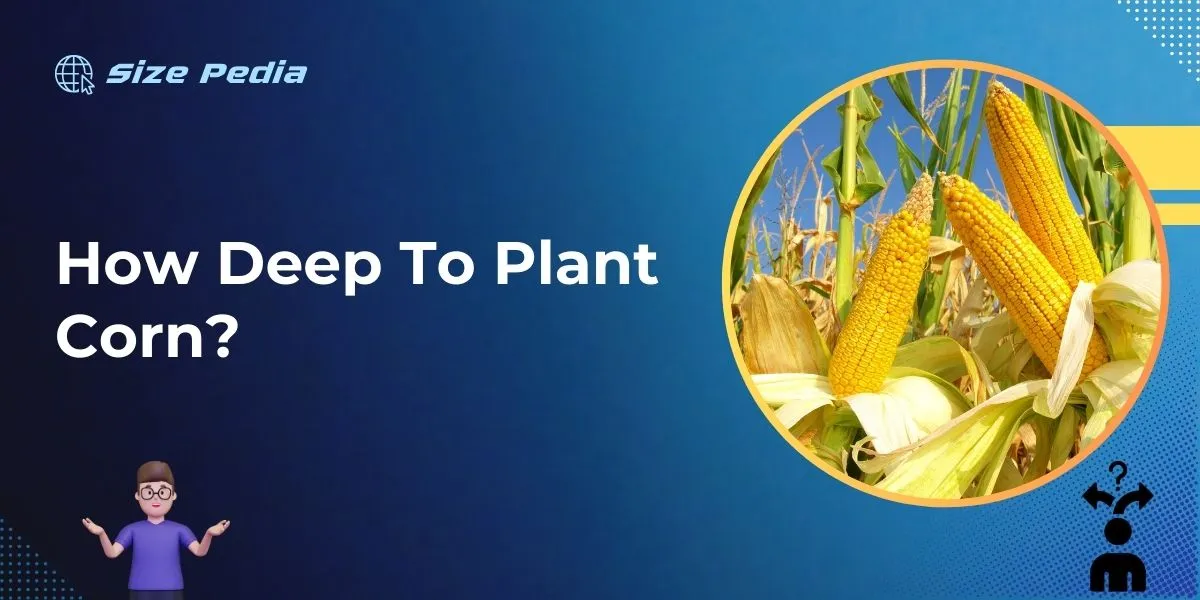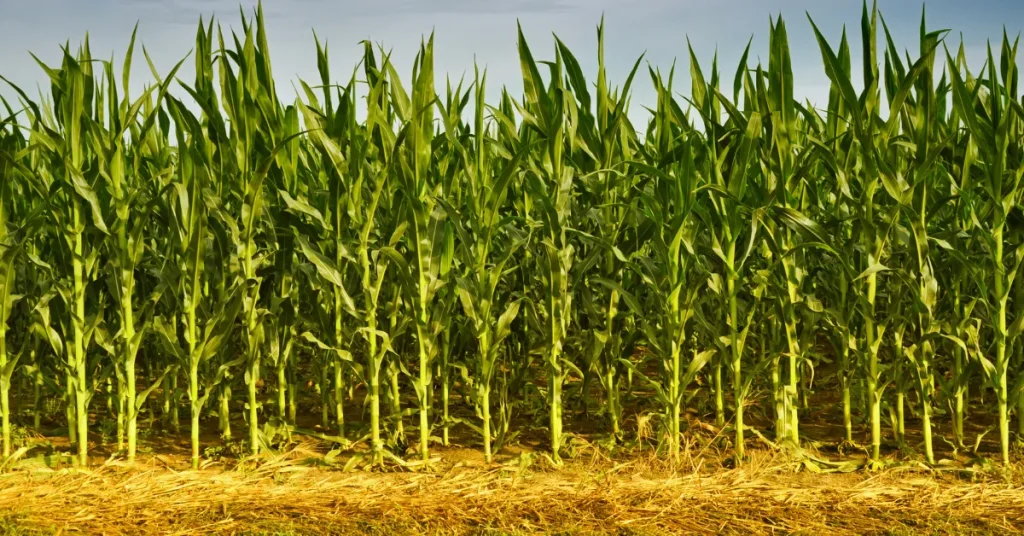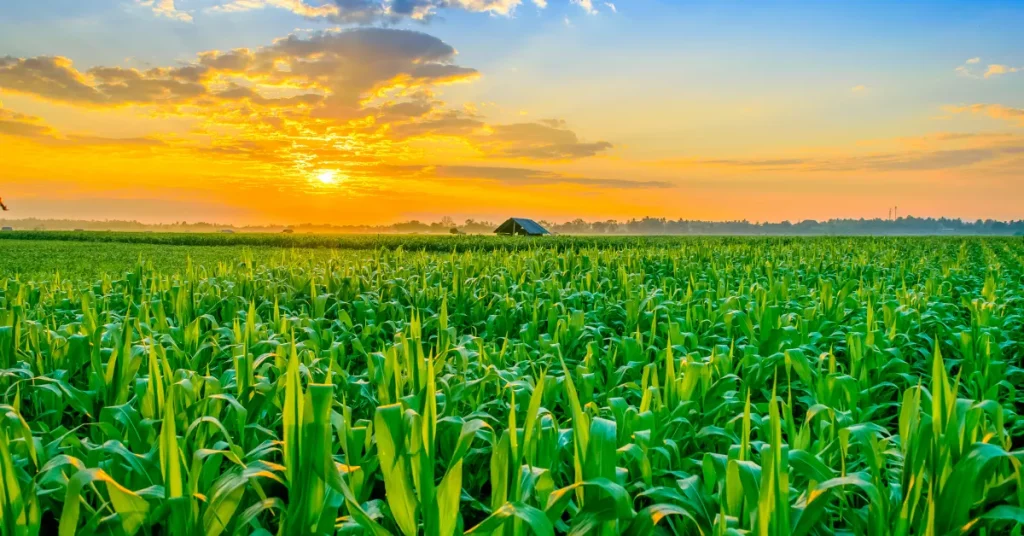Plant corn seeds 1 to 1.5 inches deep into the soil. Ensure spacing of about 9 to 12 inches between seeds.
Growing corn successfully in your garden or on a larger scale depends on proper seed planting depth, which is crucial for optimal germination and root development.
This seed depth helps protect the seeds from harsh sun and drying winds, while keeping them moist enough to sprout efficiently.
Corn, as a warm-season crop, requires soil temperatures to be at least 60 degrees Fahrenheit for germination.
Ensuring the correct depth also facilitates strong root establishment, which contributes to the overall health and stability of the corn stalks as they grow, leading to a bountiful harvest.
Proper spacing and depth are key factors in allowing adequate nutrients and sunlight to reach each plant, minimizing competition and maximizing yield.

Digging Into Corn Planting Depths
Planting corn seems straightforward, but the depth can make or break your crop.
Corn needs the right start to reach for the sun and fill your harvest baskets.
Let’s dive into the soil and uncover the secrets of planting corn at the perfect depth.
Ideal Soil Conditions
Corn prospers in soil that’s just right—a tale Goldilocks would love.
Before we talk depth, understand the soil must be prime.
It should be warm, rich, and a little crumbly.
- Temperature: Aim for 50°F and rising.
- Texture: Loamy soil holds moisture, but drains well.
- Nutrients: Fertilize based on soil tests for best results.
Prep your soil and your corn will thank you by growing strong and tall.
Why Depth Matters For Corn
Depth is not just a number; it’s the lifeline for seedlings. Plant too shallow, and birds might feast on your seeds. Too deep, and seedlings might never see the sun.
| Depth | Impact |
| 1-2 inches | Perfect for root establishment |
| Less than 1 inch | Risk of bird damage and drying out |
| More than 2 inches | Could hinder growth or prevent emergence |
Aim for a sweet spot of 1.5 to 2 inches.
This depth ensures moisture reaches the kernel and roots dig deep.
The Science Behind Seed Placement

Understanding the science behind seed placement is key to successful corn farming. It’s not just about dropping seeds into the ground. You must consider depth. Too shallow or too deep can harm your crop. Let’s dive into this below.
Germination And Depth
The right depth plays a big part in seed germination. Here’s why:
- Moisture levels: Seeds need water to grow. Placing them at the correct depth ensures they get enough moisture.
- Temperature: Deeper soil is warmer. Warmer soil helps seeds wake up faster.
- Protection: Seeds too close to the surface may dry out or become food for birds.
For corn, aim for 1.5 to 2 inches deep. This is the sweet spot for good germination.
Root Development
Root growth is crucial for a strong corn plant. Here’s the relationship between root development and seed depth:
| Depth | Root Health |
| Shallow | Roots may be weak and can’t support the plant well. |
| Deep | Roots have to work harder to get out, which can delay growth. |
| Ideal (1.5-2 inches) | Allows for a strong root base and better access to nutrients. |
Planting corn at the ideal depth supports roots so they can spread and anchor the plant. This helps your corn stand tall and healthy.
Traditional Wisdom Vs Modern Techniques
When it comes to corn planting, age-old methods meet new-age wisdom. Each generation brings fresh insights to corn cultivation, yet some foundational guidelines remain untouched by time.
Let’s delve into a comparison of traditional practices and contemporary techniques, evaluating the best depth for planting corn seeds.
Historical Practices
For generations, farmers have followed set rules for planting corn. Traditional wisdom dictates a planting depth of 1.5 to 2.5 inches. This depth offers several benefits:
- Moisture retention for better germination
- Protection from harsh surface elements
- Stable temperatures to encourage growth
Historically, farmers would manually ensure each seed reached the ideal depth. They often relied on tools like the ‘corn jabber,’ an innovation of its time, providing a consistent planting depth.
Contemporary Agricultural Insights
Modern farming techniques merge traditional knowledge with technological advancements. Experts now recommend precision seeding equipment for optimal depths that vary slightly from the past.
| Soil Type | Preferred Planting Depth |
| Loose or Sandy | 1.75 to 2 inches |
| Heavy Clay | 1.5 to 1.75 inches |
| Moist Soil | 1.25 to 1.5 inches |
Contemporary gear guarantees each corn kernel buries at the precise depth, adjusted for soil type and moisture levels. Farmers monitor soil conditions in real-time, tweaking planting depths on the go for enhanced growth rates and improved crop yields.
Optimal Planting Depths For Maximum Yields
Welcome to our deep dive into the art of corn planting! Achieving bountiful corn harvests is not just a matter of sowing seeds; it’s about sowing them at the right depth.
To help your corn reach its full potential, understanding the optimal planting depths for maximum yields is crucial.
General Guidelines
Start your planting process with some key depth pointers:
- Consistency is key – aim for an even planting depth across your field.
- 1.5 to 2 inches deep – this range works well for most soil types.
- Monitor soil moisture – seeds need to be in moist soil to germinate effectively.
- Never exceed 3 inches – deeper planting may hinder germination and growth.
Factors Affecting Seed Depth
Many elements play a part in choosing the perfect seed depth:
| Factor | Influence on Depth |
| Soil type | Sandy soils may require deeper planting; clay soils, shallower. |
| Soil temperature | Warmer soils promote quicker germination and may allow shallower planting. |
| Moisture levels | Seeds should be placed in moisture for optimal growth. |
| Weather forecast | A predicted rainfall could affect the seeding depth and timing. |
| Seed size | Larger seeds may require slightly deeper planting to access moisture and nutrients. |
By considering these factors, you can tailor your planting depth to suit your specific conditions. This will give your corn the best chance to thrive from the get-go. Remember, when it comes to planting corn, precision leads to abundance. Happy planting!
Tools And Equipment For Precise Planting
The success of planting corn often hinges on the depth at which you plant. For optimal growth, precise planting tools and equipment are essential.
These tools ensure your corn seeds nestle into the soil at the ideal depth, providing a strong foundation for germination and growth.
Planter Adjustments
To achieve precision in planting corn, tailoring your planter settings is crucial. Here’s a list of adjustments for a standard planter:
- Seed depth settings should be checked and set to the recommended 1.5 to 2 inches.
- Downforce pressure must be enough to ensure consistent depth but not too much to cause compaction.
- Ensure the seed plates align with the corn seed size for uniform delivery.
- Regularly inspect and maintain the planter’s moving parts for smooth operation.
Diy Methods
For gardeners without specialized equipment, several DIY methods can guide planting depth:
- Use a marked stick or ruler to measure depth in the soil when planting.
- Create a seed dibber with depth marks from a broom handle or similar tool.
- Check seed spacing with a homemade template to ensure even growth.
By following these simple steps, planting corn at the right depth is an easy task, even without high-tech gear.
Monitoring And Adjusting For Success

Monitoring and Adjusting for Success is a vital step in the corn planting process. To ensure the best possible crop, regular check-ups aid in identifying what the corn needs. Let’s dive into the methods to monitor soil conditions and evaluate corn post-planting.
Soil Moisture And Temperature
For corn to thrive, it needs the right soil environment. Soil moisture and temperature are critical factors:
- Moisture: Corn roots need enough water to grow. Some guidelines advise that soil should be as damp as a wrung-out sponge.
- Temperature: The ideal soil temperature for corn is 50°F (10°C) or higher. Plant corn only when these conditions are consistent.
Use a soil thermometer to check the temperature at a depth of 2 inches in the morning. Use a moisture meter to ensure the soil isn’t too wet or dry.
Post-planting Evaluations
Assessing the corn’s progress after planting gives insight into the success of your planting depth:
- Examine shoot emergence. Uneven shoots may indicate variable soil conditions.
- Look for root development. Healthy roots suggest proper planting depth.
- Check for leaf color. Yellowing could mean that the seeds were planted too deep or too shallow.
Adjust your tactics based on these evaluations. For instance, if soil moisture is low, consider irrigation. If the shoots are unequal, investigate soil compaction or nutrient levels. Change your planting depth next season if root growth seems poor.
FAQs About How Deep To Plant Corn
What Is The Ideal Depth For Planting Corn?
Corn seeds should be planted about 1. 5 to 2 inches deep. This ensures proper root development and stability. Shallower planting can lead to poor root systems and lodging problems.
Does Corn Planting Depth Vary With Soil Type?
Yes, in sandy soils, corn seeds may be planted up to 2 inches deep. In heavier, clay-rich soils, a shallower depth of 1 to 1. 5 inches is recommended. This helps with soil moisture contact and seed germination.
How Does Planting Depth Affect Corn Germination?
Appropriate planting depth is crucial for optimal germination. Too shallow, and seeds may dry out or fail to root properly. Too deep, and seeds may struggle to emerge, reducing plant stands and yields.
Can Weather Influence How Deep To Plant Corn?
Yes, in cooler, moist soils, a slightly shallower depth can aid quicker germination. In warm, dry conditions, a deeper planting may protect the seed and reduce the risk of desiccation.
Conclusion
As we’ve discovered, planting corn at the proper depth is crucial for optimal growth and yield. Aim for a depth of 1. 5 to 2 inches, ensuring moisture access and robust root development.
Remember, factors like soil type and weather conditions influence the perfect depth.
Follow these guidelines, and your corn should thrive, offering a bountiful harvest come season’s end.
Resources:
1. https://extension.umn.edu/vegetables/growing-sweet-corn
